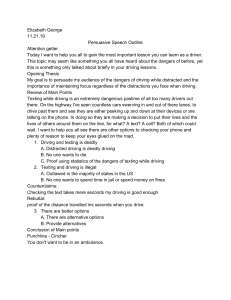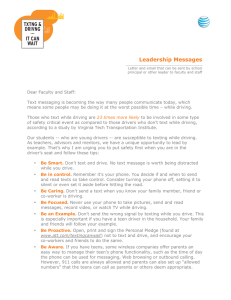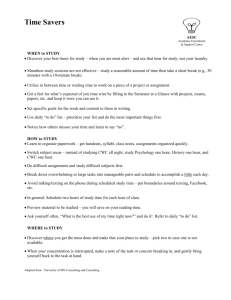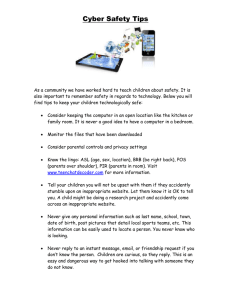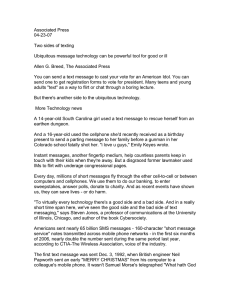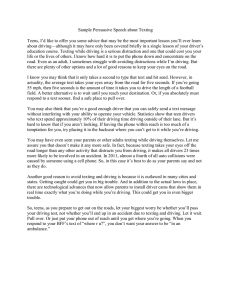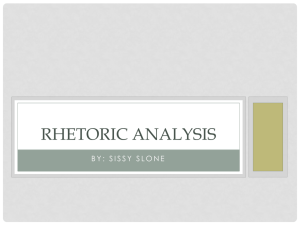How to Write a Speech
advertisement
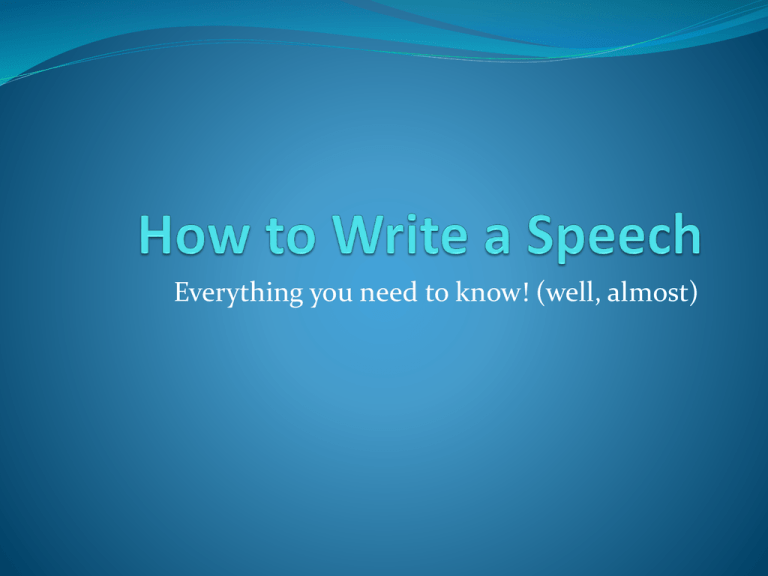
Everything you need to know! (well, almost) I. Speech Topics A. This is the purpose of your speech. B. Consider: a. The occasion: Why are you giving the speech? b. The audience: Who will watch it? c. Expectations: What is required? 1. Your interests a. b. c. d. What do you enjoy doing? What special knowledge or expertise do you have? What strong opinions and beliefs do you hold? What would you like to know more about? II. Audience Analysis A. Demographics – breaking your audience down into categories, such as 1. 2. 3. 4. 5. 6. Age Gender (male/ female) Race/ ethnicity Religion Socioeconomic Status – lower class, middle class, upper class, etc. Interests B. Importance 1. Each audience is different; find a “target” audience a. Unwise to give a speech about the benefits of meat to animal rights group III. Speech Outline A. What is an outline? 1. Information written in skeleton form 2. Focusing on only the main points B. Purpose of an Outline 1. 2. 3. 4. 5. 6. 7. Organize Ideas Helps to make eye contact Prevents from reading Prevents monotone Charlie Brown Keeps you on track (focused) Easier to present from In case you lose your place, etc. Bueller IV. Parts of a Speech A. Introduction 1. Beginning of a speech; sets the tone 2. Where you “grab” the audience 3. If possible, relate yourself to your audience in the intro. Parts of a Speech continued Parts of an Introduction a. Hook (Attention-Getter) – Must be relevant to topic * Bold/ startling statement * Humor/Joke * Quote * Ask a question - Interrogative – expect a response - Rhetorical – don’t expect a response * Fact/statistic * Anecdote - short story, usually personal, sometimes humorous * Visual aids * Make a reference Hook Example Parts of a Speech continued b. Purpose Statement * The main idea for the speech * Direct and specific * Ask, “What goal am I trying to achieve with this speech?” * Tone of voice is very important Example: “Today I will tell you about the dangers of texting and driving.” Parts of a Speech continued c. Preview Main Points * Leads into the body * Tells audience what to listen for * Usually one sentence that gives an overview of the major areas of your speech * Must use transition words Example: “To begin, texting is… (main point #1), secondly, texting is…(main point #2), finally, texting and driving …(main point #3).” Parts of a Speech continued B. Body 1. 2. The “guts” of your speech. State your main ideas and supporting details. a. 3. 4. Try to give equal time to all. If you can’t, make a sandwich with your Main Points a. b. c. 5. 2 – 5 Main Points, usually only 3 2nd Most Important Point Least Important Point Most Important Point Supporting Materials and Details a. b. Elaborate on the main points State these after the main point * Examples -Testimony – quote from someone else -Statistic – facts about main point -Story about main point -Example of main point Parts of a Speech continued C. Conclusion 1. 2. Let your audience know that you are ending. Typically do not add any new info. Parts of a Speech continued Parts of a Conclusion a. Restate purpose. Ex.: “We spoke about…” b. Review main points Ex.: “First…Second…Finally…” c. Give a final thought * Action steps (for persuasive speeches) * Give incentive (reason) for remembering your speech * Emotional impact V. Creating Your Outline A. Use standard symbols in this order: 1. 2. 3. 4. 5. Capital Roman Numerals (I, II, III) Capital Letters (A, B, C) Arabic Numerals (1, 2, 3) Lowercase Letters (a, b, c) Lowercase Roman numerals (i, ii, iii) B. Each line should contain only one idea. 1. Ex. The park is beautiful and easy to get to. a. b. The park is beautiful. The park is easy to get to. Outlining Continued Supporting points should relate to the subject directly above it. D. Indent from main point to supporting point. C. 1. 2. Usually 5 spaces (or one tab) Makes it easier to read E. Should be short and simple F. Key phrases only, not sentences G. Use transitions (First, To begin, Next, Finally, etc.) 1. Makes speech flow (not choppy) 2. Helps the audience to follow along Outline Ex.Introductory Speech Format.doc
